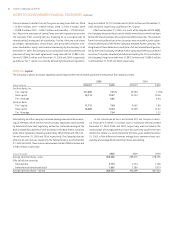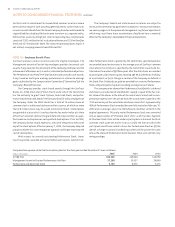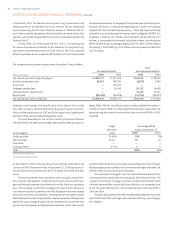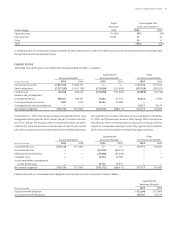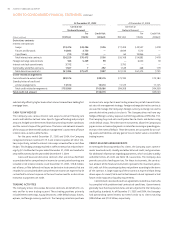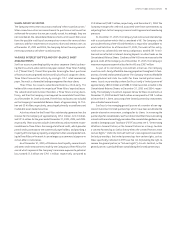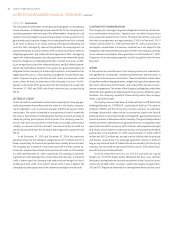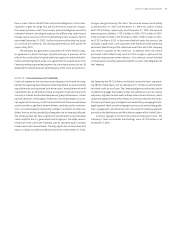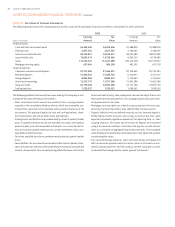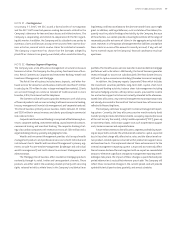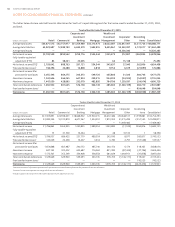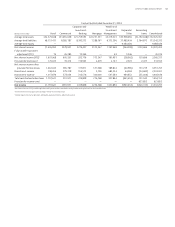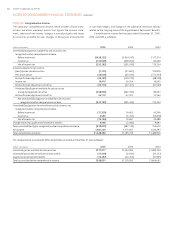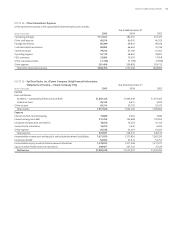SunTrust 2005 Annual Report Download - page 95
Download and view the complete annual report
Please find page 95 of the 2005 SunTrust annual report below. You can navigate through the pages in the report by either clicking on the pages listed below, or by using the keyword search tool below to find specific information within the annual report.SUNTRUST ANNUAL REPORT 93
NOTE • Derivatives And Off-Balance Sheet Arrangements
In the normal course of business, the Company utilizes various financial
instruments to meet the needs of clients and to manage the Company’s
exposure to interest rate and other market risks. These financial instru-
ments, which consist of derivatives contracts and credit-related arrange-
ments, involve, to varying degrees, elements of credit and market risk in
excess of the amount recorded on the consolidated balance sheets in accor-
dance with generally accepted accounting principles.
Credit risk represents the potential loss that may occur because a
party to a transaction fails to perform according to the terms of the con-
tract. Market risk is the possibility that a change in market prices may cause
the value of a financial instrument to decrease or become more costly to
settle. The contract/notional amounts of financial instruments, which are
not included in the Consolidated Balance Sheets, do not necessarily repre-
sent credit or market risk. However, they can be used to measure the extent
of involvement in various types of financial instruments.
The Company manages the credit risk of its derivatives and unfunded
commitments by limiting the total amount of arrangements outstanding
by individual counterparty, by monitoring the size and maturity structure of
the portfolio, by obtaining collateral based on management’s credit assess-
ment of the counterparty, and by applying uniform credit standards main-
tained for all activities with credit risk. Collateral held varies but may include
marketable securities, accounts receivable, inventory, property, plant and
equipment, and income-producing commercial properties. Collateral may
cover the entire expected exposure for transactions or may be called for
when credit exposure exceeds defined thresholds of credit risk. In addition,
the Company enters into master netting agreements which incorporate the
right of setoff to provide for the net settlement of covered contracts with
the same counterparty in the event of default or other termination of the
agreement.
DERIVATIVES
The Company enters into various derivative contracts both in a dealer
capacity, to facilitate client transactions, and also as a risk management
tool. Where contracts have been created for clients, the Company enters
into transactions with dealers to offset its risk exposure. Derivatives are
also used as a risk management tool to hedge the Company’s exposure to
changes in interest rates or other defined market risks.
Interest rate swaps are contracts in which a series of interest rate cash
flows, based on a specific notional amount and a fixed and floating interest
rate, are exchanged over a prescribed period. Caps and floors are contracts
that transfer, modify, or reduce interest rate risk in exchange for the pay-
ment of a premium when the contract is issued. The true measure of credit
exposure is the replacement cost of contracts that have become favorable
to the Company.
Futures and forwards are contracts for the delayed delivery of securi-
ties or money market instruments in which the seller agrees to deliver on
a specified future date, a specified instrument, at a specified price or yield.
The credit risk inherent in futures is the risk that the exchange party may
default. Futures contracts settle in cash daily; thus, there is minimal credit
risk to the Company. The credit risk inherent in forwards arises from the
potential inability of counterparties to meet the terms of their contracts.
Both futures and forwards are also subject to the risk of movements in inter-
est rates or the value of the underlying securities or instruments.
Derivative instruments expose the Company to credit and market
risk. If the counterparty fails to perform, the credit risk is equal to the fair
value gain of the derivative. When the fair value of a derivative contract
is positive, this indicates the counterparty owes the Company, and there-
fore, creates a repayment risk for the Company. When the fair value of a
derivative contract is negative, the Company owes the counterparty and
has no repayment risk. The Company minimizes the credit or repayment
risk in derivative instruments by entering into transactions with high qual-
ity counterparties that are reviewed periodically by the Company’s credit
committee. The Company also maintains a policy of requiring that all
derivative contracts be governed by an International Swaps and Derivatives
Associations Master Agreement; depending on the nature of the derivative
transactions, bilateral collateral agreements may be required as well. When
the Company has more than one outstanding derivative transaction with a
single counterparty, and there exists a legally enforceable master netting
agreement with the counterparty, the mark to market exposure is the net
of the positive and negative exposures with the same counterparty. When
there is a net negative exposure, the Company considers its exposure to the
counterparty to be zero. The net mark to market position with a particular
counterparty represents a reasonable measure of credit risk when there is
a legally enforceable master netting agreement, including a legal right of
setoff of receivable and payable derivative contracts between the Company
and a counterparty.
Market risk is the adverse effect that a change in interest rates, cur-
rency or implied volatility rates has on the value of a financial instrument.
The Company manages the market risk associated with interest rate, credit,
and equity derivatives and foreign exchange contracts by establishing
and monitoring limits on the types and degree of risk that may be under-
taken. The Company continually measures this risk by using a value-at-risk
methodology.
FAIR VALUE HEDGES
The Company enters into interest rate swaps to convert fixed rate assets
and liabilities to floating rates. For the years ended December ,
and , the Company recognized additional income in the net interest
income of . million and . million, respectively, related to cash
payments from net settlements and income accrued from interest rate
swaps accounted for as fair value hedges. This hedging strategy resulted in
zero ineffectiveness for the years ended December , and .
The Company maintains a risk management program to manage
interest rate risk and pricing risk associated with its mortgage lending activ-
ities. The risk management program includes the use of forward contracts
that are recorded in the financial statements at fair value and are used to
offset changes in value of the mortgage inventory due to changes in market
interest rates. A portion of the forward contracts have been documented as
fair value hedges of specific pools of loans that meet the similar assets test
as described in SFAS No. , and the qualifying pools of hedged loans are
recorded in the financial statements at their fair value. The pools of loans
are matched with a certain portion of the forward contracts so that the
expected changes in market value will inversely offset within a range of %
to %. This hedging strategy resulted in ineffectiveness that reduced
earnings by . million and . million for the years ended December
, and , respectively. The impact of the hedge ineffectiveness is



